PVP01_0605100 autophagy-related protein 8, putative (ATG8)
Disruptability [+]
| Species | Disruptability | Reference | Submitter | |
|---|---|---|---|---|
| P. berghei ANKA |
Refractory |
RMgm-1475 | Imported from RMgmDB | |
| P. berghei ANKA |
Refractory |
PlasmoGEM (Barseq) | PlasmoGEM | |
| P. falciparum 3D7 |
Refractory |
USF piggyBac screen (Insert. mut.) | USF PiggyBac Screen | |
Mutant phenotypes [+]
| Species | Stage | Phenotype | Reference | Submitter |
|---|---|---|---|---|
| P. falciparum 3D7 | Asexual |
Attenuated |
https://www.biorxiv.org/content/early/2017/10/02/195578
(Conditional)
Gene is essential for asexual growth. This is rescued by addition of IPP but the resultant parasites have no apicoplast. |
Theo Sanderson, Wellcome Trust Sanger Institute |
Imaging data (from Malaria Metabolic Pathways)
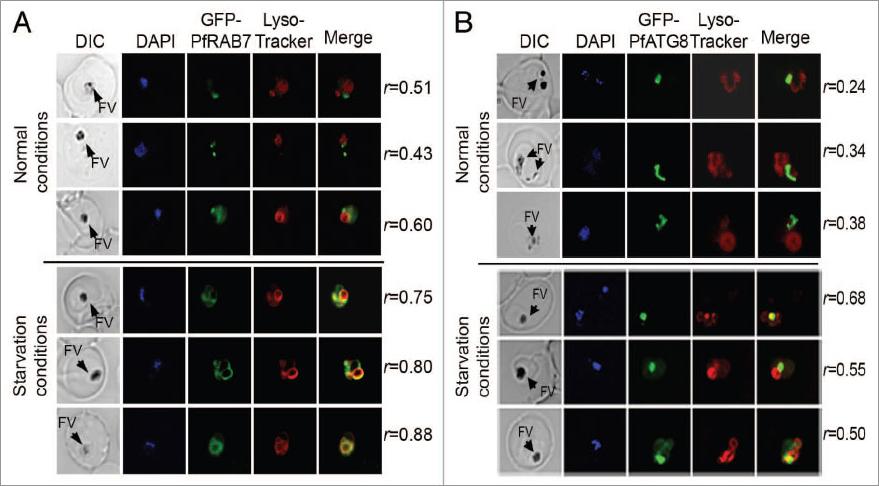
In vivo association between GFP-PfRAB7 and GFP-PfATG8 and acidic compartments. Distribution of GFP-PfRAB7 (A) or GFP-PfATG8 (B) and acidic compartments revealed in red with LysoTracker Red-DND99 is observed under normal and starvation conditions using live cell microscopy [Leica DMI 6000 microscope with MicroMAX-1300Y/HS camera (Princeton Instruments)]. The association of GFP-PfRAB7 and acidic compartments is shown in the merged image (yellow). Comparisons are between parasites at similar stages of development. The Pearson’s coefficient (r) represents the degree of colocalization in the individual images. FV; Food vacuoleTomlins AM, Ben-Rached F, Williams RA, Proto WR, Coppens I, Ruch U, Gilberger TW, Coombs GH, Mottram JC, Müller S, Langsley G. Plasmodium falciparum ATG8 implicated in both autophagy and apicoplast formation. Autophagy. 2013 Aug 29;9(10).
See original on MMP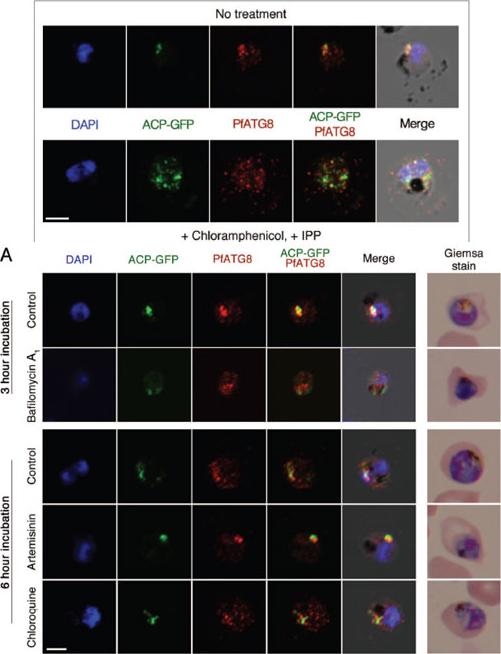
PfATG8 immunofluorescent staining in apicoplast-minus malaria parasites. The integrity of the apicoplast in these parasites was lost using treatment with the antibiotic chloramphenicol. GFP-ACP parasite cultures were rescued by supple-menting media with isopentenyl pyrophosphate (IPP), the essential product from the non-mevalonate isoprenoid precursor pathway in the apicoplast. The large apicoplast PfATG8-labeled branching, as observed in untreated parasites, is disrupted into multiple foci in apicoplast-minus parasites. These foci show colocalization of GFP-ACP and PfATG8 vesicles, although additional PfATG8 vesicles can be observed in the cytosol. DAPI is used as a DNA marker in blue. Scale bar: 2.5 μmA.PfATG8 immunofluorescent staining in 3D7 parasites treated with lysosomotropic agents and artemisinin. After 3 h incubation with 75 nM of bafilomycin A1, branching of the apicoplast is disrupted and multiple PfATG8 autophagosomes can be observed. Artemisinin treatment at a high concentration (25 μM) results in cell cycle progression arrest, and chloroquine treatment, at a concentration of 100 nM (IC80), causes disruption of the apicoplast integrity. DAPI is used as a DNA marker in blue. Scale bar: 2.5 μm.Cervantes S, Bunnik EM, Saraf A, Conner CM, Escalante A, Sardiu ME, Ponts N, Prudhomme J, Florens L, Le Roch KG. The multifunctional autophagy pathway in the human malaria parasite, Plasmodium falciparum.. Autophagy. 2013 Nov 11;10(1).
See original on MMP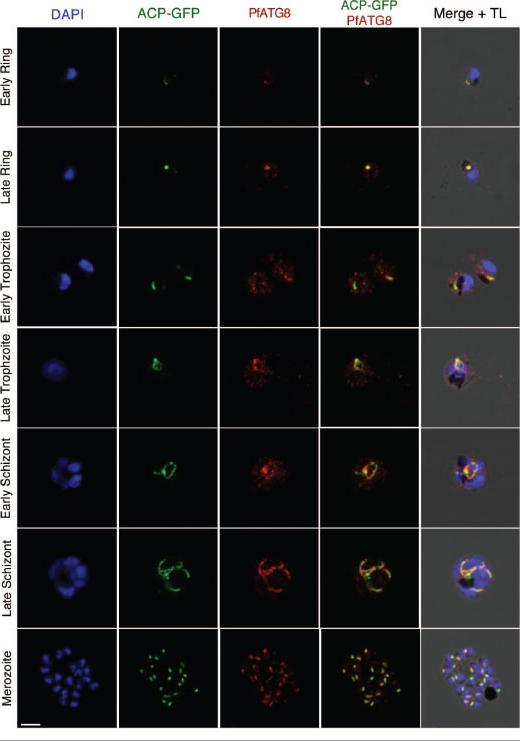
PfATG8 immunofluorescence staining throughout the erythrocytic cycle. Tightly synchronized P. falciparum D10-ACP-GFP parasites were immunolabeled with anti-PfATG8. D10 parasites express ACP-GFP, an apicoplast signal and transit peptide fused to GFP that localizes to the apicoplast. Localization of ACP-GFP and PfATG8 can be observed, although PfATG8 appears to surround the apicoplast, indicating a possible association with the outer membrane. Additional PfATG8 vesicles can be observed in the cytosol and host red blood cell from the late ring to late trophozoite stage, when parasites are metabolically active. DAPI is used as a DNA marker in blue. Scale bar: 5 μm.Cervantes S, Bunnik EM, Saraf A, Conner CM, Escalante A, Sardiu ME, Ponts N,Prudhomme J, Florens L, Le Roch KG. The multifunctional autophagy pathway in the human malaria parasite, Plasmodium falciparum.. Autophagy. 2013 Nov 11;10(1).
See original on MMP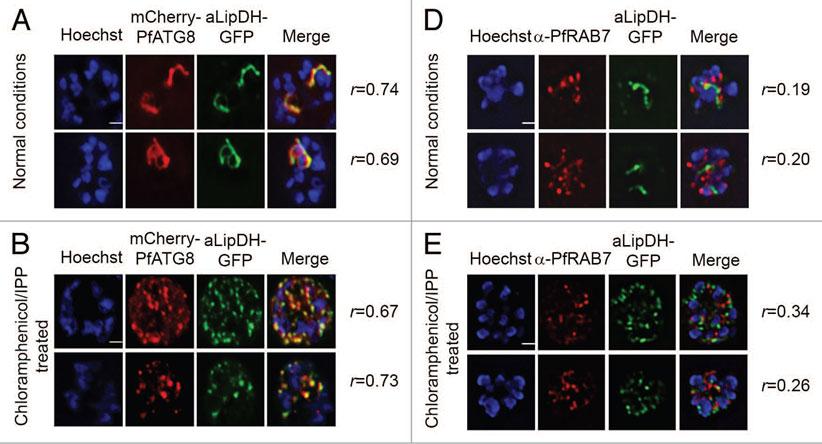
PfATG8, but not PfRAB7, colocalizes with apicoplast-targeted vesicles and apicoplast remnants. (A and B) P. falciparum expressing both mCherry-PfATG8 and aLipDH-GFP (lipoamide dehydrogenase) were treated with chloramphenicol to chemically disrupt the formation of the apicoplast, and IPP added to the culture medium to maintain viability of the parasites. DMSO control (A) and chloramphenicol treated (B) infected erythrocytes were counterstained with Hoechst 33258. The Pearson’s coefficients (r) show the degree of colocalization in each individual image. (D and E) Transgenic parasites expressing aLipDH-GFP were treated as above. Immunofluorescence analyses of untreated controls (D) or chloramphenicol/IPP treated (E) and were performed using anti-PfRAB7 antibodies (red). Hoechst 33258 (blue) was used to stain the nuclei. Scale bar: 2 μm.Tomlins AM, Ben-Rached F, Williams RA, Proto WR, Coppens I, Ruch U, Gilberger TW, Coombs GH, Mottram JC, Müller S, Langsley G. Plasmodium falciparum ATG8 implicated in both autophagy and apicoplast formation. Autophagy. 2013 Aug 29;9(10). PMID: 2402567
See original on MMP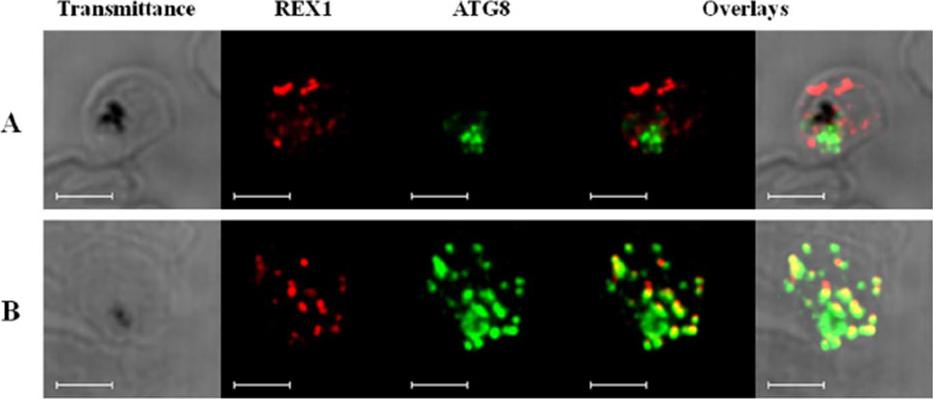
PfATG8– positive puncta. Shown are puncta for (A) control HB3 iRBC grown under normal culture conditions (B) HB3 iRBC grown for 6 hours under starvation conditions. Shown are transmittance (left), immunofluorescence vs antiPfREX1 (Maurer’s cleft marker; red; second column), immunofluorescence vs antiTgATG8 (cross reacts with PfATG8; green, third column) and overlays (right). Bar = 5 mm. Parasites grown in complete media show a cytosolic PfATG8 distribution (A, green) that appears somewhat punctate, perhaps due to at least partial localization to the apicoplast. When highly synchronized trophozoites are placed in starvation medium for 6 hrs, PfATG8 is redistributed in a much more expanded punctate fashion (B, green). Closer inspection reveals puncta at the parasite periphery, possibly near the RBC membrane. Co–staining with a marker for Maurer’s cleft (anti - PfREX1, red) shows that some PfATG8 appears to be routed to very near Maurer’s cleft (MC) (yellow dots, B middle).David Gaviria, Michelle F. Paguio, Lindsey B. Turnbull, Asako Tan, Amila Siriwardana, Debasish Ghosh, Michael T. Ferdig, Anthony P. Sinai, Paul D. Roepe. A Process Similar to Autophagy Is Associated with Cytocidal Chloroquine Resistance in Plasmodium falciparum. PLoS ONE 8(11): e79059.
See original on MMP
Redistribution of PfATG8 protein (green spots) upon starvation-induced cell death. The top three panels are strain HB3 Plasmodium falciparum grown in red blood cell culture under normal conditions; the bottom is a parasite from the same culture after being placed in starvation media (no sugar, no amino acids) for 6 h. The primary antibody was rabbit anti-TgATG8; the secondary was goat antirabbit IgG conjugated to DyLight488 fluorophore. Parasite nuclei were also stained with DAPI (blue) and mounted using Fluorogel mounting media. Samples were imaged using a spinning disk confocal microscope and 405-nm and 491-nm laser lines at 200 ms exposure and 35% laser power. Images were iteratively deconvoluted using an experimental point spread function and AutoQuantX2 software and displayed using Imaris 7.4.2. Controls (titrating antibodies, no primary antibody vs no secondary antibody) reveal staining is specific for PfATG8. Sinai AP, Roepe PD. Autophagy in Apicomplexa: a life sustaining death mechanism? Trends Parasitol. 2012 28(9):358-64.
See original on MMP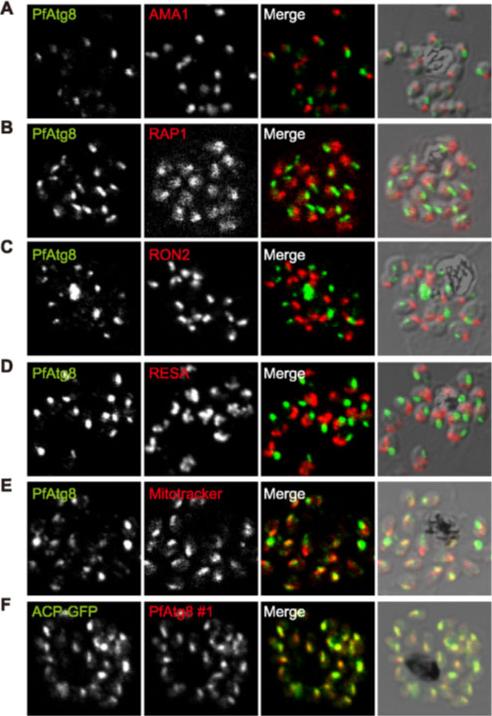
PfAtg8 localizes to the apicoplast. P. falciparum FCR3 (A–E) and P. falciparum 3D7 transfected with ACP-GFP (F–H) were stained with the indicated organelle markers and visualized by confocal microscopy (because ACP-GFP was not uniformly expressed, some merozoites displayed only faint GFP signals). Anti-PfAtg8 antibody #1 was used in (A–F), and anti-PfAtg8 antibody #2 was used in (G). Apical membrane antigen 1 (AMA1) as a microneme marker (A), rhoptry-associated protein 1 (RAP1) as a rhoptry body marker (B), rhoptry neck protein 2 (RON2) as a rhoptry neck marker (C), the ring-infected erythrocyte surface antigen (RESA) as a dense granule marker (D), MitoTrackerRed CMXRos as a mitochondria marker (E), ACPGFP (F–H) and the organellar histone-like protein PfHU (H) as an apicoplast marker were used. Scale bar, 1 mm.Kitamura K, Kishi-Itakura C, Tsuboi T, Sato S, Kita K, Ohta N, Mizushima N. Autophagy-Related Atg8 Localizes to the Apicoplast of the Human Malaria Parasite Plasmodium falciparum. PLoS One. 2012;7(8):e42977.
See original on MMP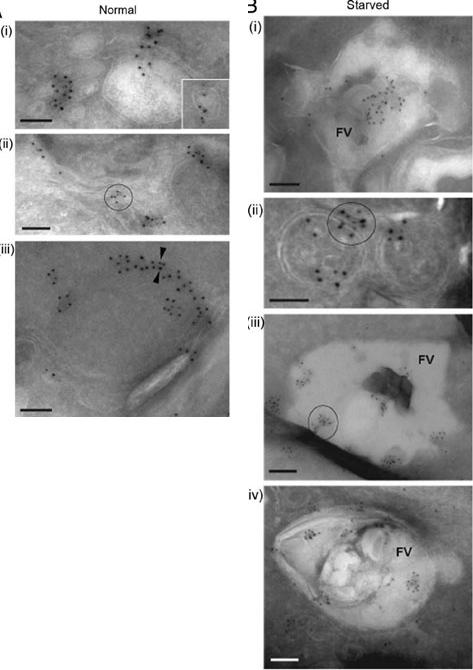
Left-normal: A iii) and PfRAB7 (5-nm gold particles, A iii). (A) PfATG8 and PfRAB7 decorate vesicles (i and insert) and membranous tubules (ii) in the cytoplasm. On some occasions, Immunogold staining of P. falciparum under normal growth conditions and under conditions of amino acid-deprivation (starved) reveals the subcellular localization of PfATG8 (10-nm gold particlesPfATG8 and PfRAB7 occurred at the periphery of double-membrane-bound organelles (iii, arrowheads). Scale bars: 100 nm. PfATG8 and PfRAB7-labeled vesicles (i and insert) and membranous tubules (ii) and PfATG8 also occurred at the periphery of double membrane bound organelles (iii, arrowheads).Right-starved: PfATG8 and PfRAB7 associatedwith large structures corresponding to the food vacuole (FV; i). Costaining of PfATG8 and PfRAB7 is also visible on small double-membrane-boundstructures (ii), or very large FV vesicles (iii and iv). Scale bars: 100 nm. Upon amino acid deprivation an enhanced colocalization of PfATG8 and PfRAB7with the acidic food vacuole (FV) occurred (i, iii and iv) and also on small double-membrane-bound structures (ii).Tomlins AM, Ben-Rached F, Williams RA, Proto WR, Coppens I, Ruch U, Gilberger TW, Coombs GH, Mottram JC, Müller S, Langsley G. Plasmodium falciparum ATG8 implicated in both autophagy and apicoplast formation. Autophagy. 2013 Aug29;9(10).
See original on MMP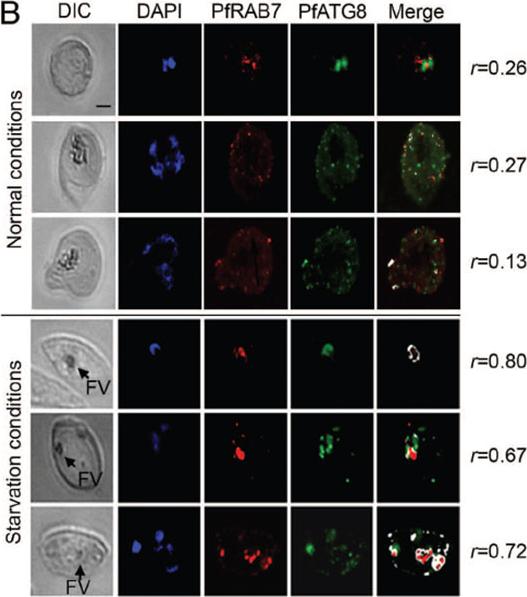
Amino acid deprivation induces fusion between PfRAB7-positive and PfATG8-positive compartments. Association of PfRAB7 and PfATG8 (PF10_0193) under normal or amino acid-deprivation conditions using IFA. The distribution of PfRAB7 (red: excitation: 530 to 560 nm and emission 572 to 647 nm; anti-PfRAB7 peptide antibody) and PfATG8 (green: excitation: 450 to 490 nm and emission 500 to 550 nm; anti-PfATG8 peptide antibody) is shown. Nuclei are stained with DAPI (blue: excitation: 340 to 380 nm and emission 450 to 490 nm). The association of PfRAB7 and PfATG8 is shown in white (merge). The images were obtained using a Leica DMI 6000 microscope with MicroMAX-1300Y/HS camera (Princeton Instruments). The Pearson’s coefficient (r) represents the degree of colocalization between PfRAB7 and PfATG8 in the individual images. FV: food vacuole. In nonstarved parasites, PfATG8, but not PfRAB7, was found on the intact apicoplast membrane and on apicoplast-targeted vesicles. Amino acid starvation provoked increased colocalization between PfATG8- and PfRAB7-labeled vesicles and acidification of the colabeled structures consistent with PfRAB7-mediated maturation of PfATG8-positive autophagosomes.Tomlins AM, Ben-Rached F, Williams RA, Proto WR, Coppens I, Ruch U, Gilberger TW, Coombs GH, Mottram JC, Müller S, Langsley G. Plasmodium falciparum ATG8 implicated in both autophagy and apicoplast formation. Autophagy. 2013 Aug29;9(10). [Epub ahead of print]
See original on MMP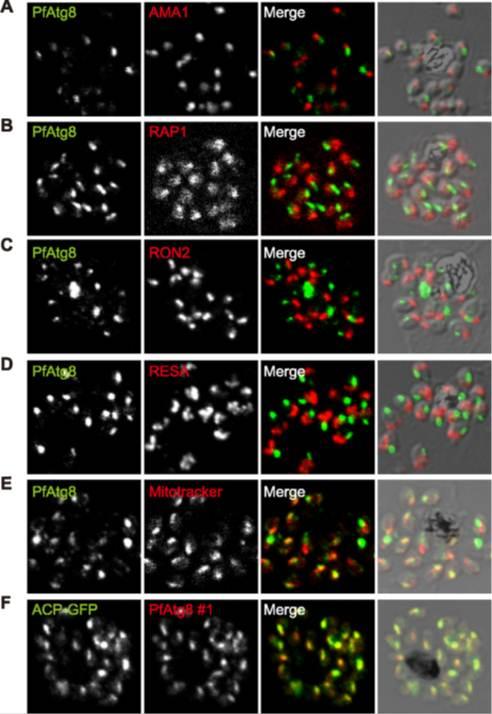
PfAtg8 localizes to the apicoplast. P. falciparum FCR3 (A–E) and P. falciparum 3D7 transfected with ACP-GFP (F–H) were stained with the indicated organelle markers and visualized by confocal microscopy (because ACP-GFP was not uniformly expressed, some merozoites displayed only faint GFP signals). Anti-PfAtg8 antibody #1 was used in (A–F), and anti-PfAtg8 antibody #2 was used in (G). Apical membrane antigen 1 (AMA1) as a microneme marker (A), rhoptry-associated protein 1 (RAP1) as a rhoptry body marker (B), rhoptry neck protein 2 (RON2) as a rhoptry neck marker (C), the ring-infected erythrocyte surface antigen (RESA) as a dense granule marker (D), MitoTrackerRed CMXRos as a mitochondria marker (E), ACPGFP (F–H) and the organellar histone-like protein PfHU (H) as an apicoplast marker were used. Scale bar, 1 mm.Kitamura K, Kishi-Itakura C, Tsuboi T, Sato S, Kita K, Ohta N, Mizushima N. Autophagy-Related Atg8 Localizes to the Apicoplast of the Human Malaria Parasite Plasmodium falciparum. PLoS One. 2012;7(8):e42977
See original on MMP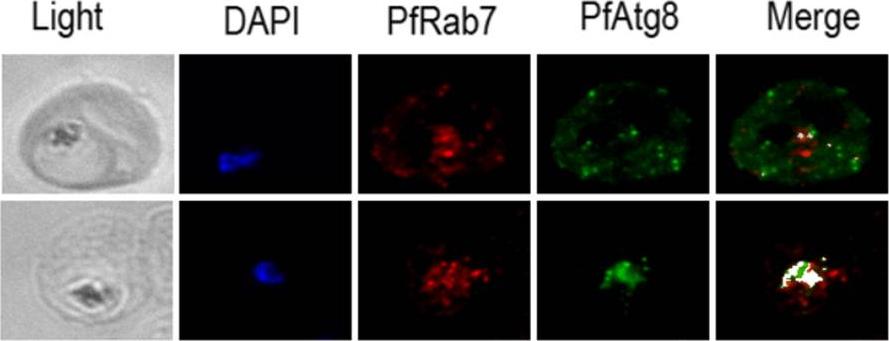
Immunofluorescence showing colocalization (white) of PfRab7 (red) and PfAtg8 (green) in normal and starvation culture conditions. PfRab7+/PfAtg8+ double labeled autophagosomes can be found at the food vacuole suggesting that it, rather than lysosomes, is the final lytic compartment in malaria parasite autophagy.Ben-Rached F & Langsley G (2014) Rab GTPases in Plasmodium. These figures were published in the Encyclopedia of Malaria edited by Marcel Hommel and Peter G. Kremsner (Springer New York)
See original on MMP
Effect of E64 and pepstatin treatments on autophagy. Synchronized early/mid trophozoite stage parasites were cultured in the presence of DMSO (Control) or inhibitors (22 mM E64, 220 mM pepstatin) for 15 hours, and then analyzed by IFA using anti-Atg8 antibodies. A. The parasite images show punctate localization pattern of Atg8, which is distributed throughout the control andpepstatin-treated parasites. The E64-treated parasite show accumulation of Atg8 signal in a narrow region around the swollen food vacuole, most likely because cytoplasm has been pushed to the periphery in these parasites due to the enlarged food vacuole. B. Z-sections for control and E64-treated parasites were captured and the composite image shows punctate signal for Atg8 (Atg8), the stained-nucleus (DAPI), erythrocyte and parasite boundaries (Bright field), and a merge of all three images (Merge). Note that both control and E-64 treated parasites appear to have a few Atg8 puncta in the food vacuole, but not any significant accumulation of the puncta in the food vacuole of E64-treated parasites.Navale R, Atul, Allanki AD, Sijwali PS. Characterization of the Autophagy Marker Protein Atg8 Reveals Atypical Features of Autophagy in Plasmodium falciparum. PLoS One. 2014 Nov 26;9(11):e113220.
See original on MMP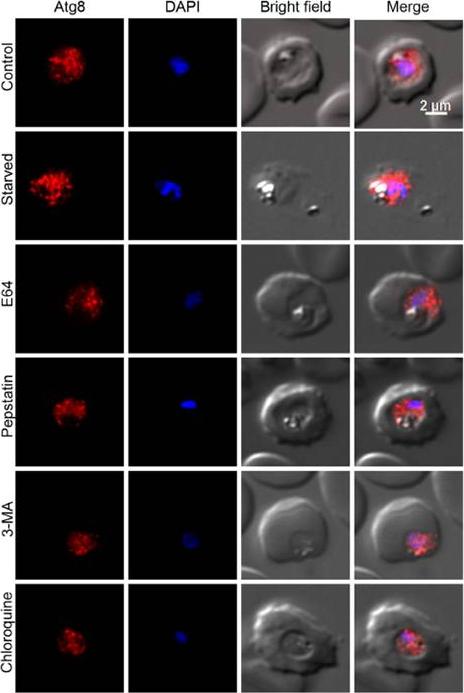
Effects of typically used autophagy inducer/inhibitors on Atg8 levels and localization. Early/mid trophozoite stage parasites were cultured in HBSS (Starved) or in complete medium containing DMSO (Control) or the indicated autophagy inhibitors (5 mM 3MA, 30 nM CQ, 22 mM E64, and 220 mM pepstatin (Pep); all except 3MA are at concentrations 3x IC50) for 8 hours, and then parasites were evaluated for localization of Atg8 by IFA using anti-Atg8 antibodies. The parasite show similar Atg8 signal regardless of the treatment. The experiment was repeated three times, and the results were reproducible.Navale R, Atul, Allanki AD, Sijwali PS. Characterization of the Autophagy Marker Protein Atg8 Reveals Atypical Features of Autophagy in Plasmodium falciparum. PLoS One. 2014 Nov 26;9(11):e113220.
See original on MMP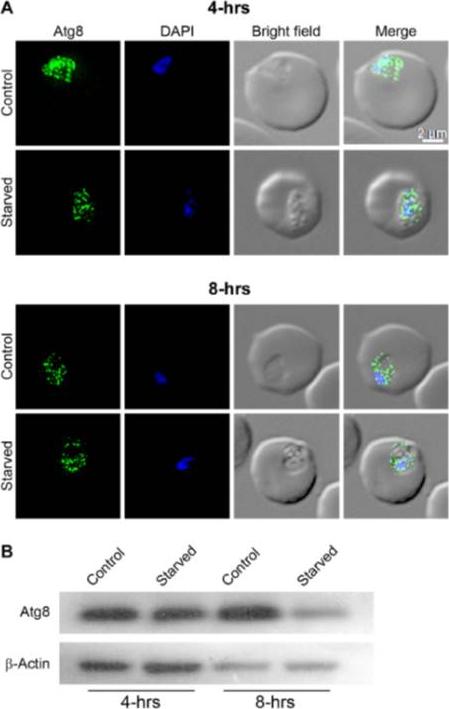
Effect of starvation on Atg8 levels and localization. The P. falciparum early/mid trophozoite stage parasites were cultured in complete medium (Control) or HBSS (Starved), samples were collected after four (4-hrs) and eight (8-hrs) hours of culture, and processed for localization of Atg8 by IFA (A) or expression level of Atg8 by western blotting (B) using anti-Atg8 antibodies. As a loading control, b-actin expression was also assessed in the same samples. A. The Atg8 signal appears to be associated with punctate structures, most likely autophagosomes. The parasite images show almost similar localization patterns of Atg8 in control and starved parasites at both the time points. B. The western blot shows significantly reduced level of Atg8 in parasites starved for 8 hours compared to the 8 hourcontrol parasites, suggesting downregulation of Atg8. Similar b-actin levels in control and starved parasites indicate that similar sample amounts were loaded. Navale R, Atul, Allanki AD, Sijwali PS. Characterization of the Autophagy Marker Protein Atg8 Reveals Atypical Features of Autophagy in Plasmodium falciparum. PLoS One. 2014 Nov 26;9(11):e113220.
See original on MMP
Expression and localization of Atg8 in asexual erythrocytic stages. The indicated stages of P. falciparum were evaluated for the presence of Atg8 by IFA using anti-Atg8 antibodies. The images of each indicated stage show the presence of Atg8 specific signal (Atg8), nucleic acid staining (DAPI), the parasite and the erythrocyte boundaries (Bright field), and the merged of all three images (Merge). The Atg8 signal is present throughout the parasite in all the stages shown, and appears to be associated with punctate structures, most likely autophagosomes. The scale bar shown is identical for this and all the figures containing IFA images.Navale R, Atul, Allanki AD, Sijwali PS. Characterization of the Autophagy Marker Protein Atg8 Reveals Atypical Features of Autophagy in Plasmodium falciparum. PLoS One. 2014 Nov 26;9(11):e113220.
See original on MMP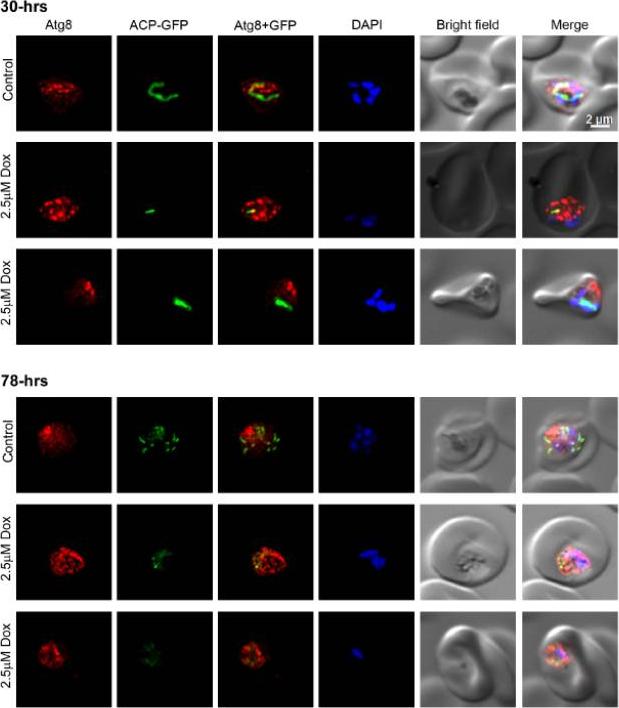
Atg8 in doxycycline-treated parasites. Synchronized ring stage P. falciparum D10 parasites expressing the apicoplast marker ACP-GFP were cultured in the presence of DMSO (Control) or doxycycline (2.5 mM Dox) for two full cycles, samples were collected at 30-hours (30-hrs) and 78-hours (70-hrs) time points, and processed for IFA using anti-Atg8 antibodies. The parasite images indicate that both control and treated parasites have strong signal over the elongated apicoplast at the 30-hours time point, indicating a healthy dividing apicoplast. The 78-hours control parasite have multiple intensely-stained apicoplasts, indicating that it has matured to multinucleate stage and the apicoplast has divided, whereas the treated parasites have weak fragmented signal, suggesting disruption of the apicoplast. Note that Atg8 signal pattern in the control and treated parasites mostly remains unchanged.Navale R, Atul, Allanki AD, Sijwali PS. Characterization of the Autophagy Marker Protein Atg8 Reveals Atypical Features of Autophagy in Plasmodium falciparum. PLoS One. 2014 Nov 26;9(11):e113220
See original on MMP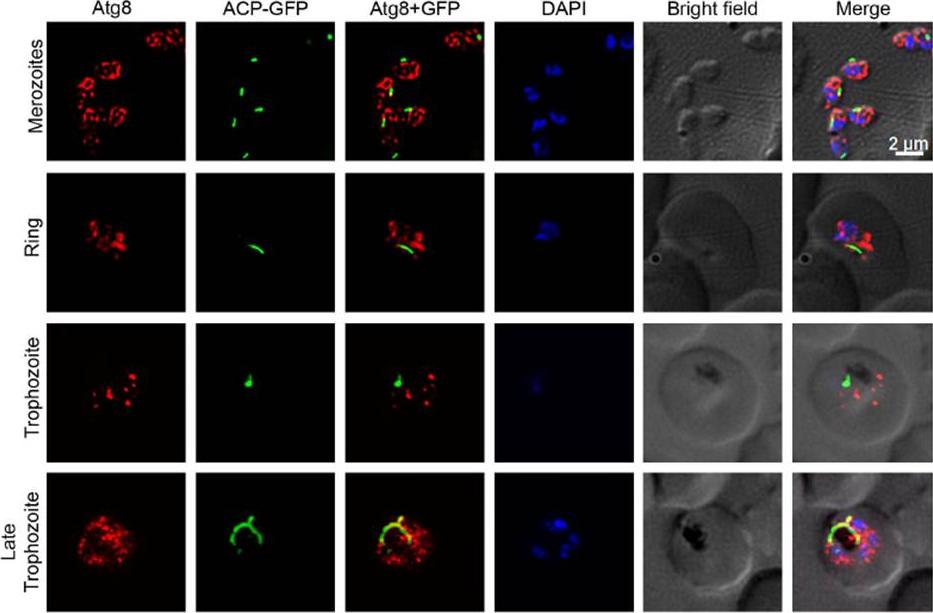
Colocalization of Atg8 and the apicoplast. The indicated stages of P. falciparum D10 parasites expressing the apicoplast marker ACP-GFP were evaluated for colocalization of PfAtg8 with the apicoplast. The images show PfAtg8 (Atg8) and apicoplast (ACP-GFP), merged Atg8 and apicoplast signals (Atg8+GFP), nuclear stain (DAPI), parasite and erythrocyte boundaries (Bright field), and the merged of all the four images (Merge). Note that PfAtg8 signal is distributed throughout the parasite as puncta, which partially overlaps with the apicoplast, particularly in the late trophozoite stage.Navale R, Atul, Allanki AD, Sijwali PS. Characterization of the Autophagy Marker Protein Atg8 Reveals Atypical Features of Autophagy in Plasmodium falciparum. PLoS One. 2014 Nov 26;9(11):e113220. PMID:
See original on MMPMore information
| PlasmoDB | PVP01_0605100 |
| GeneDB | PVP01_0605100 |
| Malaria Metabolic Pathways | Localisation images Pathways mapped to |
| Previous ID(s) | null |
| Orthologs | PBANKA_0504100 , PCHAS_0504200 , PF3D7_1019900 , PKNH_0604100 , PVX_001860 , PY17X_0505200 |
| Google Scholar | Search for all mentions of this gene |